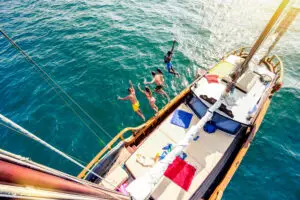
Ormos Skorponeri Anchorage Travel Guide
Ormos Skorponeri Anchorage Travel Guide – Safe Mooring in Evia,

The crown jewel of the Dodecanese — a place where ancient mythology meets modern marinas. This sun-drenched island sits where the Aegean and Mediterranean seas embrace, offering calm anchorages, steady winds, and a timeless charm that lures every sailor back. Whether you crave adventure or peace, Rhodes sailing Greece promises both — wrapped in turquoise waters, golden sunsets, and stories as old as the gods themselves.
Sailing into Rhodes feels like arriving at a living museum surrounded by a painter’s dream. What makes Rhodes unique isn’t just its history or beaches — it’s the perfect fusion of heritage, sunshine, and sea.
Rhodes has stood as a maritime crossroads for over 2,000 years. Today, medieval walls and modern marinas coexist, making it one of the most photogenic sailing destinations in Greece.
A UNESCO World Heritage Site, the Old Town of Rhodes offers cobbled lanes, stone gates, and harbor views that whisper tales of the Knights of St. John. It’s a must-visit for those who love walking through history before returning to their yacht.
From lively Faliraki to tranquil Lindos Bay, Rhodes offers beaches for every sailor’s taste. You’ll find calm turquoise waters perfect for anchoring or paddleboarding right off your stern.
With over 300 sunny days a year, Rhodes is a sailor’s dream for consistent weather and warm breezes.
In Greek mythology, the island was a gift from Helios, the Sun God. Every sunrise feels like his blessing upon those sailing its shores.
2.6 Easy to Explore by Land or Sea
Its well-connected road network makes inland exploration effortless after docking.
Expect friendly tavernas, local wines, and warm hospitality — a blend of Greek soul and island simplicity.
For a deeper cultural perspective, see the full Rhodes Island overview.
Rhodes lies at the southeastern edge of Greece, forming part of the Dodecanese Islands — a strategic chain just off the coast of Turkey. Its location makes it a natural bridge between Europe and Asia, giving sailors countless route options.
From Athens, Rhodes is about 420 nautical miles southeast — roughly two days of sailing for experienced crews.
Rhodes is proudly Greek, despite being closer to Turkey than to Athens.
The island is surrounded by both the Aegean Sea (north and east) and the Mediterranean Sea (south and west).
Rhodes is a gateway to Symi, Chalki, Tilos, and beyond — making it perfect for Greek island sailing holidays that combine short passages with endless discovery.
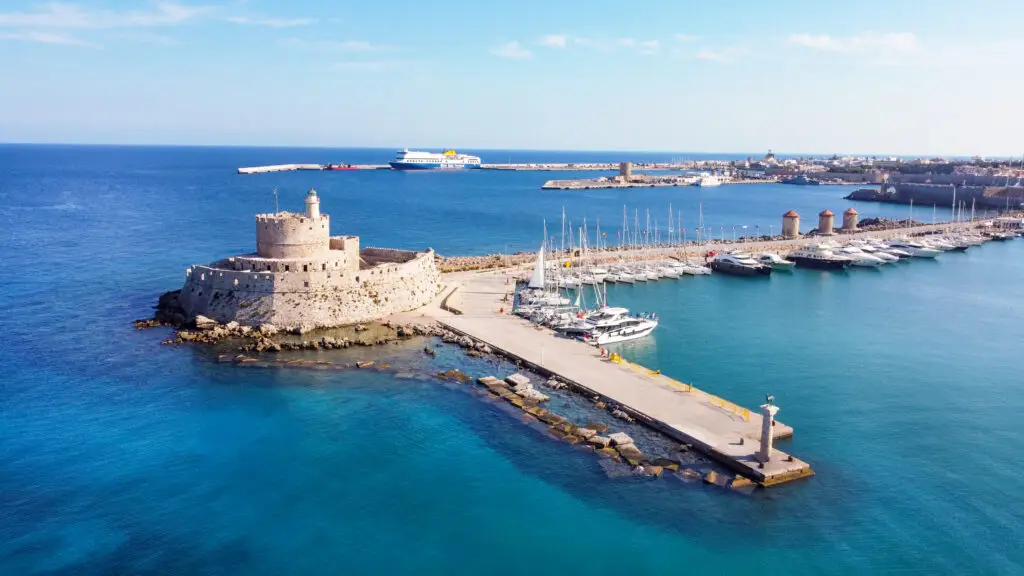
Timing matters when planning your Rhodes sailing Greece adventure. The island’s seasons shape everything — from sea temperature to crowd size and Meltemi intensity.
A sailor’s sweet spot. The weather is warm but not scorching, marinas are peaceful, and wildflowers paint the hills. Winds are moderate, perfect for beginners or relaxed cruising.
Expect long, sunny days and lively marinas. The Meltemi winds peak in July, offering brisk sailing — ideal for confident skippers. It’s also the busiest tourist season, so book berths early.
Perhaps the best time to sail Rhodes. The sea remains warm, crowds thin out, and the winds mellow. Many experienced sailors prefer this period for its balance of weather and tranquility.
Mild but windy, with reduced services in smaller harbors. Not ideal for beginners, but liveaboards often anchor long-term.
Season | Sea Conditions | Wind Strength | Ideal For |
Spring | Calm, warm | Light–Moderate | Exploration, photography |
Summer | Moderate–Choppy | Strong Meltemi | Experienced sailors |
Autumn | Warm, steady | Moderate | Ideal cruising |
Winter | Unstable | Variable | Long-term mooring |
The Meltemi is the dominant summer wind in the Aegean — a dry, northerly breeze that can blow from Force 5 to 7. It cools the air but can challenge unprepared sailors.
Unlike the Cyclades, Rhodes sits at the Meltemi’s southern edge. Winds here are milder and more predictable, especially on the east coast where the landmass provides shelter.
Morning calms often give way to afternoon gusts. Around Prasonisi (southern tip), expect strong funnels that attract windsurfers and advanced skippers alike. In contrast, Lindos Bay and Kolymbia stay calm even when nearby seas stir.
Understanding these patterns helps you harness the wind rather than fight it — turning your Greek island sailing holiday into a journey of confidence and freedom.
Rhodes isn’t just another stop on the Aegean map, it’s the island that makes every sailor fall in love twice: once with its beauty, and again with how effortless it feels to explore. From sunrise over Lindos to an evening ouzo in Mandraki, the island has a rhythm that suits both the seasoned skipper and the relaxed cruiser.
Rhodes serves as a natural base for Dodecanese exploration. From here, you can set sail to Symi, Tilos, or Chalki within a few hours, short hops that still feel like full adventures. Its central position allows flexible itineraries whether you head north or west.
Unlike the gusty Cyclades, the east and south coasts of Rhodes are calmer, with sheltered bays like Lindos and Kolymbia offering perfect overnight anchorages. The predictability of the weather makes trip planning stress-free, a rare gift in Greek sailing.
From Mandraki Harbor’s iconic deer statues to the modern Rhodes Marina, you’ll find top facilities, fresh water, power, and easy provisioning. Maintenance services, chandlers, and even luxury spa marinas make Rhodes one of the best-equipped islands for long stays.
After mooring, wander into a taverna for grilled octopus, local wine, or meze shared with laughing locals. In Rhodes Town, nightlife hums gently, from rooftop bars to live bouzouki by the sea.
Rhodes is your springboard to quick escapes, the Symi sailing route, for example, is a favorite one-day trip among crews who want both challenge and beauty.
In short, sailing Rhodes Greece offers the best blend of comfort, culture, and convenience in the Aegean.
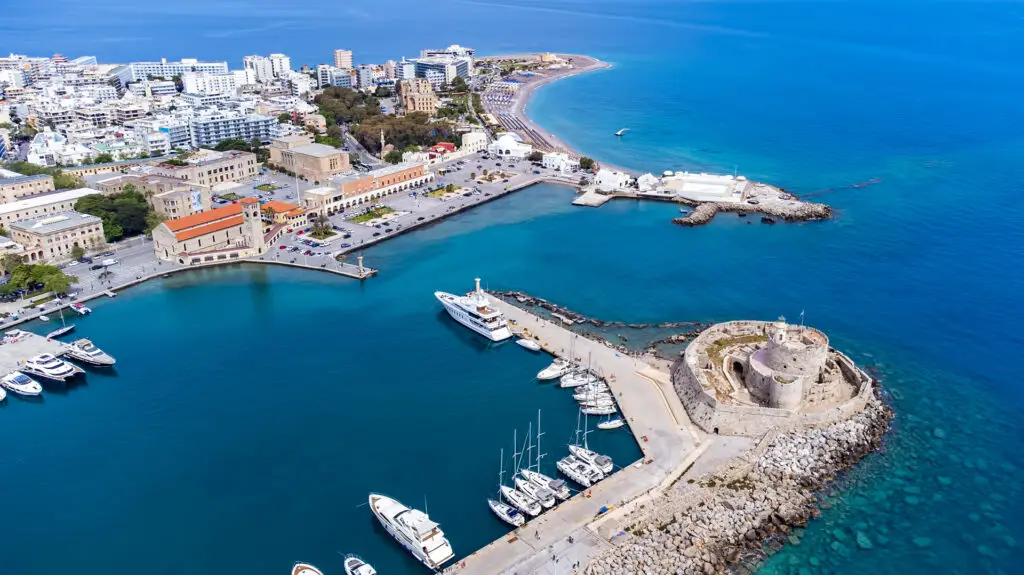
For sailors, anchorages are where memories are made. Rhodes offers a wide range, from lively ports to quiet bays where the only sound is the sea brushing your hull.
See detailed local mooring data on the Rhodes anchorages page for coordinates, depths, and amenities.
Once home to the Colossus of Rhodes, Mandraki is the beating heart of the island. Located right beside the Old Town, it’s ideal for those who want easy access to shops, nightlife, and sightseeing. Space is limited, so book early, especially in July and August.
Just south of Mandraki, this is the modern counterpart, a fully serviced marina with berths for yachts up to 120 meters. It’s clean, secure, and close to supermarkets and technical services.
Anchoring here feels like docking in a postcard. The turquoise waters are shallow and calm, protected from most winds. You can take the dinghy ashore to explore the Acropolis above the whitewashed town.
Just next to Lindos, this small inlet offers incredible scenery and a sense of privacy. Ideal for day stops and snorkeling.
Halfway between Lindos and Rhodes Town, Kolymbia offers an excellent anchorage with sandy bottoms and nearby tavernas.
Named after the actor who fell in love with this cove, it’s one of Rhodes’ most photogenic stops. Clear waters and rocky surroundings make it perfect for diving straight off your deck.
On the west coast, this small port offers mooring options and ferries to Chalki. Winds can be stronger here, but it’s great for those seeking a local vibe.
A hidden gem near Feraklos Castle, offering good shelter from northerly winds and a peaceful night’s rest.
At the island’s southern tip, Prasonisi is wild and windy, a playground for windsurfers. It’s not ideal for overnight stays but spectacular for a daytime adventure.
Each anchorage has its charm, and that variety is what makes sailing in Rhodes truly special.
When you’ve had your fill of busy harbors, Rhodes still has surprises waiting for you. Some of its hidden beaches can only be reached by boat, the ultimate sailor’s privilege.
Soft sand, shallow waters, and peace. Drop anchor a few hundred meters offshore and swim to a quiet cove beneath the ruins of Feraklos Castle.
A rugged, remote beach on the west coast, great for sailors seeking solitude. It offers crystal-clear waters but be mindful of occasional swells.
Known for its sea caves and pebbled shore, Traganou near Faliraki is a dream for snorkeling. You can moor nearby and explore by dinghy.
Untouched and wild, Glyfada offers deep anchorage and stunning sunsets. Few tourists reach this side, making it ideal for quiet overnight stays.
Historic thermal springs with art deco architecture, accessible from the water. Anchor outside the small cove and enjoy a swim or spa visit.
Sailing to these secret bays in Rhodes is like time-travel — a glimpse of Greece before mass tourism, seen from the deck of your own yacht.
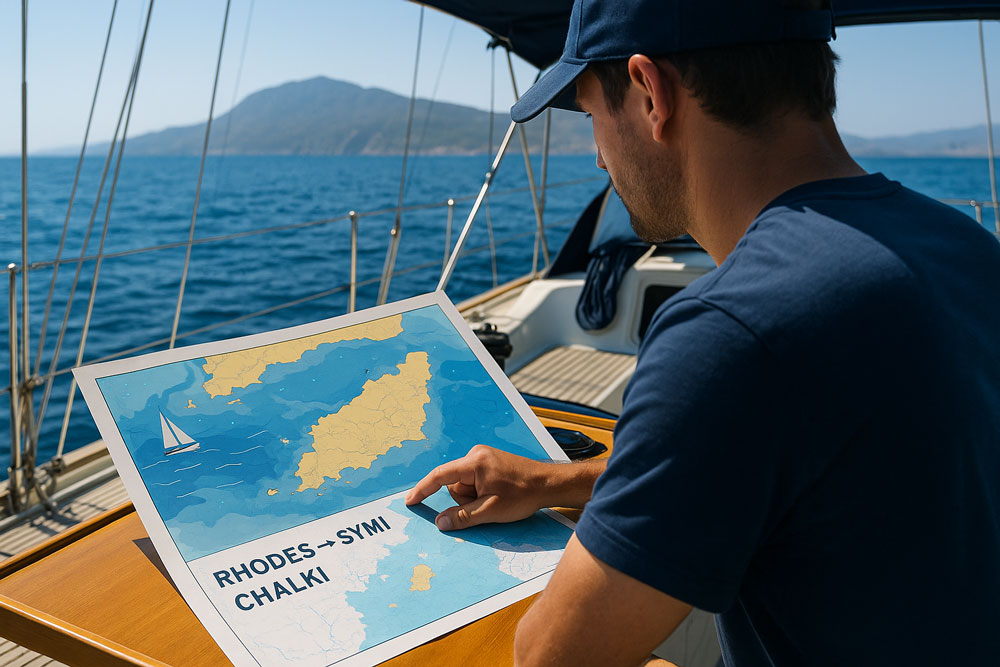
With its variety of coasts and nearby islands, Rhodes is perfect for sailors who love both short hops and full circumnavigations. Below are the most rewarding Rhodes sailing routes, each offering a different mix of adventure and relaxation.
For detailed route planning, visit the full Rhodes itinerary page with maps and nautical miles.
Start from Rhodes Marina and sail south toward Lindos. Stop at Anthony Quinn Bay and Kolymbia on the way. Gentle winds, sandy bays, and turquoise water make this route perfect for beginners or families.
Continue from Lindos to Prasonisi. Here the Aegean and Mediterranean meet, creating dynamic sailing conditions. Ideal for those craving challenge and speed.
From Kamiros Skala up toward Kritinia and Monolithos, this coast feels untouched. You’ll encounter strong gusts and fewer amenities, a true sailor’s experience.
This is the most popular Dodecanese route. Depart from Mandraki, cross to Symi (about 25 NM), and drop anchor in its postcard-perfect harbor lined with neoclassical houses.
Explore more on the Symi sailing page.
A circular trip westward to Chalki and uninhabited Alimia Island. Great for a 2–3 day mini voyage with peaceful anchorages and old fort ruins to explore ashore.
These sailing routes around Rhodes combine everything, from calm bays to lively ports, mythological landmarks, and hidden anchorages. Whether you plan a week-long loop or spontaneous day sails, Rhodes rewards you with balance: adventure and serenity in perfect measure.
Once you’ve mastered the waters around Rhodes, the true magic begins, island-hopping through the Dodecanese. Each nearby island feels like a new world, yet the sailing distances are short enough for relaxed day trips.
Rhodes sits at the heart of the Dodecanese, making it an ideal hub for quick crossings. Symi, Tilos, and Chalki each offer their own charm — from neoclassical harbors to sleepy fishing villages and untouched anchorages.
A 7–10 day voyage allows plenty of time for each stop, short swims, and spontaneous detours.
Island-hopping from Rhodes offers the best of Greek sailing, freedom, discovery, and the luxury of choosing your pace.

Beneath the surface of Rhodes lies another world worth exploring. The island’s crystal-clear waters and rocky seabeds make it a diver’s paradise, even straight off your yacht.
Always dive with a buddy, display a diver’s flag, and check for local restrictions. Many marinas offer air refills and rental gear, so you can keep your load light.
Sailing in Rhodes isn’t just about what you see above the waves, it’s what waits beneath them that makes it unforgettable.
Good preparation keeps your voyage smooth. Rhodes has excellent infrastructure for provisioning, fuel, and water, especially around the main harbors.
The Rhodes Marina complex has supermarkets, bakeries, and supply stores within walking distance. You can also order groceries directly to your boat through local apps or marina services.
Fuel is available at Rhodes Marina, Mandraki, and Kamiros Skala. Water and shore power are available at most organized marinas, usually paid per use.
Most sailors plan a single refuel and restock stop every 4–6 days, enough to explore freely without rushing back to port.
Sailing in Greece is straightforward once you understand the basics. Rhodes follows the same national maritime regulations that apply across Greek waters.
Always keep your boat registration, insurance, and crew list ready for inspection. Greek Port Police may request them at check-in or when entering new ports.
All yachts sailing in Greek waters must pay the TEPAI cruising tax, based on vessel length. Payment can be made online or at local tax offices.
Foreign-flagged boats also need a Transit Log, usually handled by the first port of entry.
Make sure your yacht carries the required safety gear: lifejackets, fire extinguishers, flares, and updated charts. Random inspections are common.
Mooring fees in Rhodes vary, around €25–40 per night for mid-sized yachts at marinas, and less at municipal quays. Water and power are extra.
Anchor off whenever possible, or combine one marina night with several nights at free moorings.
For updated rates and official regulations, visit the Port fees & rules.
Understanding these small details means smoother sailing, and fewer surprises when docking.
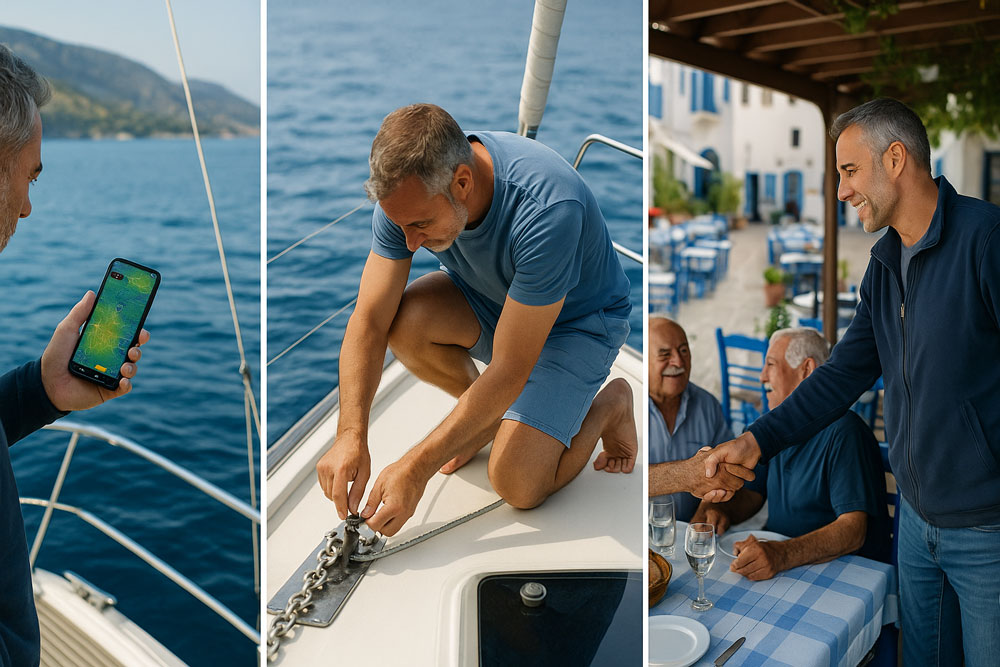
Every skipper knows that success at sea depends on small habits. Rhodes rewards preparation and respect for its rhythm, part Aegean, part Mediterranean, all Greek.
The Meltemi might skip a day or surprise you early. Always check updates from Poseidon System or Windy before leaving port. Winds often increase after noon, especially near Prasonisi and the west coast.
Rhodes bays have mixed sand and weed bottoms, so give your anchor time to set. A 5:1 scope is ideal for security, especially during Meltemi bursts. Lindos, Haraki, and Kolymbia offer the best holding grounds.
Rhodes averages 12–13 hours of sunshine per day in summer. Use wide hats, light clothing, and reef-friendly sunscreen — especially during midday passages.
Greeks are friendly and informal, but etiquette matters. A polite “Kalimera” goes a long way when you need a favor from the harbor master or taverna owner.
Many tavernas along the coast (like those in Lindos and Haraki) allow free mooring for customers. Always ask first and show appreciation, it’s part of the island’s unwritten sailor’s code.
If you have a few extra days, include Symi, Chalki, or Alimia in your plan, reachable within a half-day sail.
Strong winds can appear suddenly. Build an extra day or two into your schedule to wait out storms in comfort rather than stress.
Pro Tip: Combine flexibility with curiosity — Rhodes always rewards sailors who follow both instinct and forecast.
Sailing Rhodes isn’t just about routes, it’s about rhythm. Here are practical Rhodes travel tips for sailors to help you feel at home on the island:
In short, Rhodes welcomes sailors warmly but expects the same respect in return.
Below are the most common questions sailors ask about Rhodes sailing Greece, simplified and optimized for clarity and quick reference.
The best months are May, June, September, and October. During these periods, the weather is warm, winds are moderate, and marinas are less crowded.
The Meltemi winds blow from the north between Force 4–7 in July and August. The east coast is more sheltered, making it ideal for anchoring and day sails.
Both. Rhodes has free anchorages in bays like Lindos, Haraki, and Kolymbia. Marinas like Mandraki or Rhodes Marina charge nightly mooring fees, usually between €25–40.
Yes — Rhodes is less than 20 km from the Turkish coast. You can cross to Marmaris or Fethiye, but you must clear customs and immigration. Always check current maritime entry rules.
Rhodes is known for its medieval Old Town, the Colossus legend, and over 300 sunny days per year. For sailors, it’s the mix of calm seas, modern marinas, and mythical atmosphere that makes it unforgettable.
July and August are peak months, especially Mandraki and Symi Harbor. Reserve berths early or anchor off nearby bays to avoid delays.
Yes, most Rhodes bays offer good holding and protection from northerly winds. Avoid exposed west-coast coves during Meltemi days and always set a drag alarm overnight.
Rhodes Marina and Mandraki are surrounded by supermarkets, fuel stations, and marine supply stores. For remote areas, stock up before leaving Rhodes Town.
Watch for strong gusts near Prasonisi, rocks near Kallithea, and shallow sand patches in Lindos. Also, be mindful of swimmers close to beaches.
Popular next stops include Symi, Chalki, Tilos, and Nisyros. These routes form the Dodecanese sailing circuit, famous for calm crossings and cultural variety.
Rhodes is more than just an island, it’s a living chart of history, beauty, and wind. For sailors, it’s where myth meets seamanship, where every sunrise feels like a blessing from Helios, and where every anchorage holds a story waiting to be told.
Whether you’re docking in Mandraki or drifting off Lindos under the stars, sailing in Rhodes is the kind of adventure that stays with you long after you’ve left its shores.

Ormos Skorponeri Anchorage Travel Guide – Safe Mooring in Evia,
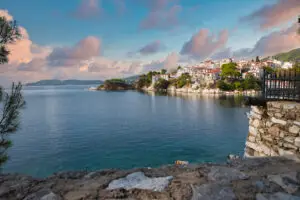
Sailing Route from Skiathos to Evia – The Quiet Passage
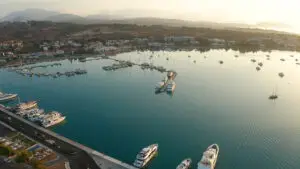
Contact Us Now to Create Your Dream Sailing Itinerary [email protected]